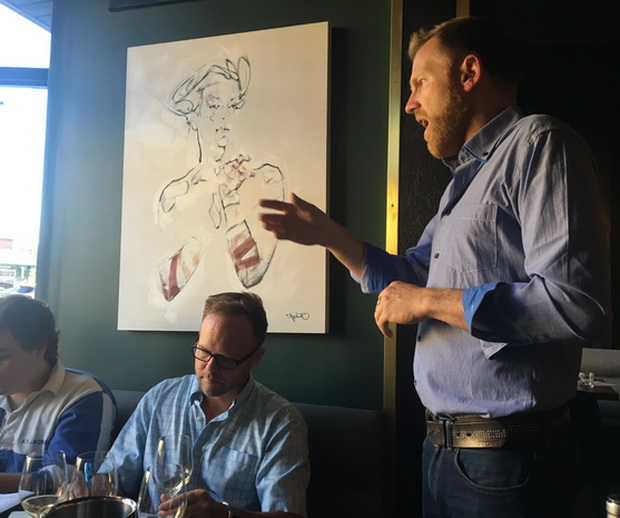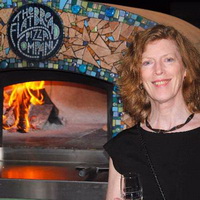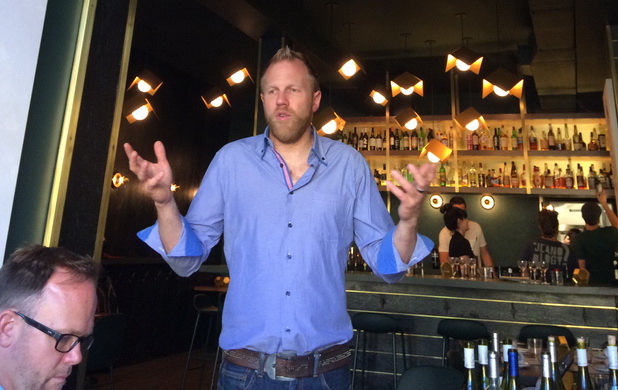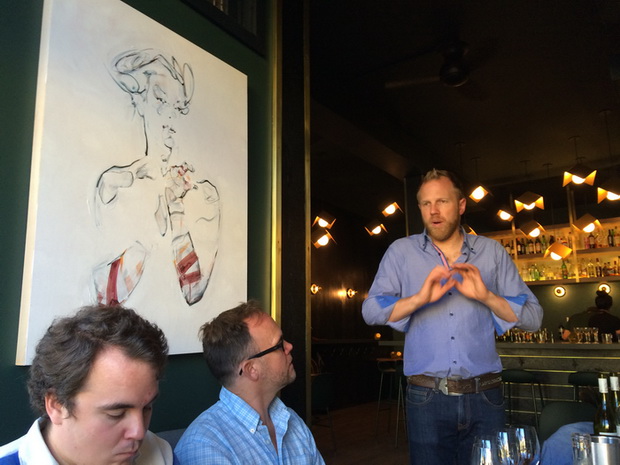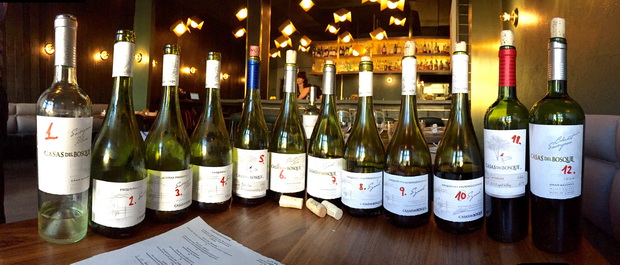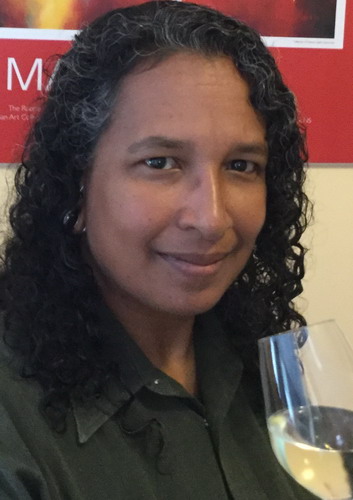Canada’s top wine writers and sommeliers gathered in our nation’s capital recently for a tasting of Casas del Bosque Chilean wines with head winemaker, Grant Phelps.
Grant’s presentation style is a perfect blend of wit and education.
Have you ever met someone when, after hearing them speak for like five minutes, you think, “What a smart dude, and funny too!” Imagine meeting a winemaker like that. It sure made a portfolio of wine tasting both refreshing and fun.
Our group of Ottawa-based sommeliers and wine writers got a real treat meeting Casas del Bosque’s head winemaker, Grant Phelps. How so?
Well, he’s putting cool climate Chilean Sauvignon Blanc on the map, he’s making some world-class cool climate Pinot Noirs and Syrahs at remarkably inexpensive prices.
He doesn’t take himself too seriously, he does everything he can to pursue an environmentally conscious winemaking career. He cracks jokes here and there, and he doesn’t hold back his opinions.
So where do I start sharing snippets of Grant’s winemaking attributes? Well, he holds a Master’s Degree in Oenology and Viticulture; he’s made wine in several countries including Australia, Argentina, California, Hungary, New Zealand, Oregon and Chile.
He’s originally from New Zealand, so he was definitely breastfed Sauvignon Blanc (his own words, not mine).
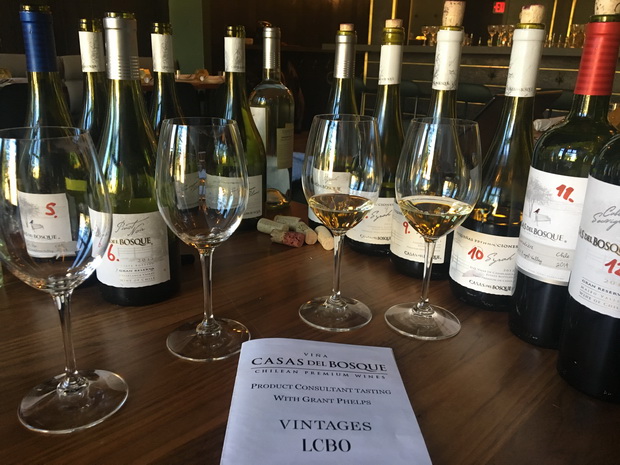
As cliché as this may sound, the proof is indeed in the pudding. After tasting Casas del Bosque’s current lineup of Sauvignon Blanc, I found myself being excited for Sauvignon Blanc once again.
See, like Grant, I too have outgrown the hyper-vegetal, uber-crisp, one-dimensional Marlborough New Zealand trend.
Plus, it’s impressive to see someone break heaps of sweat to make wine from grapes grown in the near frigid Casablanca region of Chile. Grant will talk your ear off about all the ways he has tried to fight frost against his grapes.
So, after being near floored by the deliciousness of some boisterous and textured small-lot Sauvignon Blancs, Pinot Noirs and Syrahs, you start to think, well, how does something like this happen?
For Grant, he was intrigued by cool climate viticulture.
Grant shared an experience he had some 20 years ago tasting wine in the UK while researching for his thesis. The first thing he went for was some ‘exotic’ Chilean Pinot Noir, and it was mediocre at best.
Whatever it was to Grant sparked a massive research into South American viticulture, though. Today, the pergola-trained vines, ill-advised harvesting times and over-extracted fruit is no more.
Oh, by the way, can believe Grant was a legit DJ? Hence the gangsta props.
Here’s to Grant and all his work bringing Chile on the world stage and working toward sustainable winemaking in South America.
Jane Staples
Wine Columnist, Ottawa Wedding Magazine
On Sept. 20th, I attended a professional tasting of Chilean wines from Casas Del Bosque Winery, which is located near Val Paraiso, Chile.
Having recently attended a tasting of New Zealand wines, I was curious to compare these Chilean wines from a different New World region.
Casas Del Bosque chooses to be a boutique winery, with production of 90,000 cases per year. Working with small quantities allows them to dedicate their production to the highest standards and to produce the best quality of wines. The many awards their wines have won attest to this goal.
I was intrigued to discern how distinct these wines were, compared to those from New Zealand. The winemaker, Grant Phelps, aims to create herbal, textural wines with zesty acidity.
He purposely downplays the fruit flavours to create a distinctly Chilean style that reflects the cool climate viticulture.
I’m always interested in how wine complements food, so I asked him about Chilean cuisine. I learned that Chile has fantastic “mariscos”- scallops, calamares and mussels — so it was easy to immediately see how these ultra-crisp, herbal whites would be ideal to pair with seafood.
Casas Del Bosque also produces Pinot Noir, Syrah, Carménère and a totally delicious Cab Sauv that won Gold at the Concours Mondial de Bruxelles.
Having achieved the goal of developing world-class award-winning wines, Grant is now delving into Enoturism, with the opening of a hotel on the grounds of the winery.
The hotel is made from recycled container boxes used for siding and aptly named “Winebox.”
This was another informative wine tasting, shared with colleagues over tasty tapas of olives, cheese and cured ham.
I have added a trip to Chile to my Wine Bucket List!
Jon Steeves
Accredited Sommelier & Blogger
The Casasa del Bosque estate vineyards Chief winemaker, Grant Phelps, led a private tasting of 12 of his wines from the 2012 to 2016 vintages.
Grant shared his passion for the art and science of wine making, harnessing terroir and top quality fruit into unique masterpieces.
We learned about his experiences with the terroir, climate change, vinification and vitification gained from his upbringing in New Zealand and the past 16 years in Chile as a winemaker and about his unique experiences with New Zealand wines in comparison to his love for Chilean.
Geologically, some vineyards sit atop a 170 million year old cretaceous era granite with others atop 50 cm of red volcanic clay crust formed 35 million years ago. An iron-rich top soil is prevalent in the Casablanca Valley which is where the majority of Chilean premium wine production takes place.
Grant is passionate about the differentiation between Chilean wine growing and other New World climates. It’s interesting that Chile is referred to as New World by most, given Vitis Vinifera came to Chile in the 16th century.
Chilean vineyards are primarily located at a Southern latitude equivalent to the Northern equivalent of around the Mediterranean Sea and predominantly offers a Mediterranean climate alike to that of California and Bordeaux.
Vineyards are relatively close to the Pacific Ocean to the West, the Andes Mountain range to the East, and the Atacama Desert to the North.
These boundaries have helped protect Chilean vines from phylloxera. Chilean root stock is Phyloxera free which has helped to keep costs lower.
With only 18km from the ocean and 75º degree days, the growing season in Casablanca Valley is similar to the Champagne region. The diurnal shift goes from 2-27C creating unique acidity development and fruit character.
Chilean viticulture terroir diversity includes the Northern Atacama desert, where it hasn’t rained in 2,000 years, to Southern climate where it rains 320 days a year.
Climate change has recently begun to impact the growing season and occasionally costs major consequences due to spring frost.
Chilean irrigation systems have been customized to the terroir and climatic conditions. With climate change, pressure is on the vineyard managers to foresee sudden drops in temperature at bud break and around times when the vines are vulnerable to frost.
Night picking is regularly used at Casas del Bosque to preserve skin composition in cooler temperatures.
Remaining true to character, the Casas del Bosque is a small boutique winery with only 90,000 cases per year produced.
The chief winemaker is proud to represent the firm who is claimed to have a strong commitment to the environment, terroir and impact on the planet and to where quality comes ahead of quantity.
The Casas del Bosque estate encompasses 220 hectares in the Casablanca Valley currently in production of white varietals of Sauvignon Blanc, Chardonnay and Riesling; and red varietals of Pinot Noir and Syrah. Casas del Bosque grows Carménère and Cabernet Sauvignon fruit likewise, producing red wines from Rapel Valley and Maipo valley fruit.
I was pleasantly appreciative to have experienced the diversity between the Sauvignon Blanc small production vertical from 2013, 2014, 2015 and 2016 vintages, showing wonderful fruit, high acidity and complexity.
As well,the mix between stainless steel and aged barrels and differentiation between exceptionally cool vintage of 2013 and other vintages where hang time influenced the fruit development and resulting concentration.
My personal favourite from the tasting was the 2012 vintage small production Syrah (majority clone 300) from eight year old vines from hillside blocks, cropped at 4.8 tonnes per hectare. Its intense fruit concentration, fantastic acidity and complexity lit up my senses and intrigue.
This wine portfolio was exceptional, diversified and has anchored Chilean white and red production in a category worthy of trying more and leaving me looking forward to next years vintage.”
Jennifer MacDonald Havers
Wine Columnist, Ottawa Citizen
Even before this tasting began, I had learned something – Chile was making cool-climate wines? How was this possible?
This was an event I was really looking forward to, especially given my love of another cool-climate winemaking region – Canada!
We were introduced to the Casablanca region of Chile by Grant Phelps, the winemaker of Casas del Bosque. This relatively new growing region is also the coolest growing region of Chile.
This region has been developing over only the past 25 years and primarily growing Chardonnay, Sauvignon Blanc, Pinot Noir, Syrah and in the warmer areas, Carménère and Cabernet Sauvignon. Casablanca is still a small part of Chile’s overall production (maybe 3%) but growing.
As Canadians know, winemaking in cool climates is not an easy task. In Casablanca, coastal fog rolls in and can provide moisture where disease can strike the vines. Luckily, once fog burns off in this area, the sun comes out, and sunny skies are perfect for ripening grapes.
Due to frost in 2016, about 20% of the winery’s initial Chardonnay and Pinot Noir were lost. Crops can be protected from frost by various methods, namely misting the vines with water (good protection but only until around -6ºC) or wind machines and bonfires.
Water is an interesting challenge in Casablanca. There is no surface water, meaning that water supplies are coming from very deep reserves.
Irrigation for a semi-arid climate such as this is an expensive part of production. Soils are more grey clay and sand in flatter areas, and ancient granite at higher elevations.
Much of the granite is covered by a shallow layer of red volcanic clay, however the vines have no problem punching down into the granite. Due to its age, it’s brittle and crumbles easily.
All of these characteristics factor into the wines we tasted. First up was a flight of Sauvignon Blanc. Picked at night to retain acidity and flavours, Grant vinifies all of his Sauvignon Blanc on the skins for additional texture and tannin.
The resulting wines have a briny note, and would be a great complement to scallops, oysters, and other seafood.
The Pinot Noir flight was next. Original plantings in this region were mostly with clones intended for sparkling wine.
Gradually, these have been replaced and resulting wines have greatly improved.
Again, these wines are left on the skins, and hand punched, contributing to a nice texture and balance of tannin. Wines are briny and earthy, with some notes of cherry and strawberry.
To wrap up our introduction to the cool-climate wines, we were introduced to Syrah. Quite new to this growing area (in the last ten years), there was quite a variety in the vintages we tasted, but they all earned favourable reviews among our group.
I was quite surprised at the variation due to different vintage conditions, however, all showed deep, beautiful colour extraction, and a lot of body and flavour.
Overall, we saw quite a range in the wines tasted from Casas del Bosque, and the care and deliberate nature of some of the wine making decisions are evident.
With the Sauvignon Blanc in particular, which I think can sometimes seem like a straightforward wine, fermenting on the skins helped to heighten the wine’s complexity, add texture, and make it more interesting.
It was a pleasure to learn about this new (to me!) area in Chile, and I hope to see more of these wines available in Canada. After all, we Canadians can truly appreciate the cool-climate challenges the winemaker faces.
Nicole Lewis
Algonquin Sommelier Graduate
On Tuesday, September 20th, Dan Rabinovtich, President of Azureau Wines and Spirits, hosted Grant Phelps, rock star winemaker of Casas del Bosque. There was a similar event the day before in Toronto, where Azureau is based.
I had the pleasure of attending the Ottawa event as part of Natalie MacLean’s team of writers. The Ottawa tasting was held at the recently opened Bar Laurel – owned by Jon and Kate Svazas of Fauna fame.
Grant Phelps is originally from New Zealand and has been the winemaker at Casas del Bosque for last 8 years. This winery has garnered a number of awards from the International Wine and Spirit Competition (IWSC) in London over the last few years for both its Sauvignon Blanc and Syrah wines.
Before we started tasting the wines, Grant set the stage by giving us an overview of Chile in terms of wine, then more specifically about the Casablanca Valley, where the Sauvignon Blanc, Pinot Noirs and Syrahs are grown.
Interesting facts about Chile
– 4300 km long and averages only 175 km wide, runs along the southwest coast of South America, making it the longest, skinniest country in the world.
– Geographically and climatically it is dominated by the Andes to the east and the Pacific Ocean to the west.
– Diversity of wine growing climate from the Atacama Desert in the north – above the tropic of Capricorn – and in the south, the northern tip of Patagonia (Bio-Bio).
– Chile generally has a Mediterranean climate, with warm, dry summers and moist, mild winters with little snow and rare sub-zero temperatures.
– Since 1554, Chile has been growing wine grapes, nevertheless, during Spanish rule, production was limited and Chile was required to purchase the bulk of its wine from Spain.
– Despite Chile’s colonial connection to Spain, its winemaking has been most heavily influenced by France, in particular by the Bordeaux approach.
Interesting facts about the Casablanca Valley
– The Valley is unique as a wine growing region in Chile, as the glaciers did not get past the Coastal Mountains, thus there is no river in this valley, nor is there any groundwater.
– The soils in the valley are largely unaffected by alluvial and colluvial effects – there has been only localized movement of soil.
– The soils in the flatter part of the valley are clays mixed with some sand, but the hillsides are composed of granites.
– The 50 centimetre top of red volcanic clay is a result of the eruption of Tinguiririca, the same volcano where a flight from Uruguay crashed and the survivors ate the dead to survive in 1972.
– The granites, formed during the Cretaceous period, 110 million years ago, is softer than the clay.
– Hottest month of the year is January with an average 24 hour temperature of 16.5 degrees Celsius (the temperature may reach as high as 27degrees Celsius and as low as 2 – 3 degrees Celsius in the same day).
– This big diurnal shift is essential to great wine making.
– Fog is a common daily occurrence until 10 – 11 a.m., then it is sunny.
– On account of the frosts and the weather, winemaking in the valley is cost intensive (natural gas for ‘torches’ and electricity to pump water from deep wells through irrigations systems).
– The Valley has 750 degree growing days in a season – similar to Champagne.
– The winery is 15 km inland, alongside the valley and 18km from the ocean.
Interesting facts about Grant’s wine making philosophies and techniques
– The Sauvignon Blanc grapes are 100% night-harvested – to bring the grapes in cold.
– The Sauvignon Blanc undergoes 7 days of skin contact to give mouth-feel and texture.
– Marlborough Sauvignon Blancs are good aperitif wines, but not food-friendly.
– Grant used to work for Villa Maria, making Marlborough Sauvignon Blancs.
– Abhors American oak, he finds it too overpowering in his white wines.
– Uses French barrels for a warmer ferment and to blow off some of the aromatics.
– Interested in making age-worthy Sauvignon Blancs unlike those from New Zealand and even the Loire.
– There is absolutely no bâtonnage, no acidification, de-acidification or malolactic fermentation in Grant’s white wines.
– Has created a niche for more citrus-driven, food-friendly and age-worthy Sauvignon Blancs.
– Grant’s “Field of dreams” theory about structure and Sauvignon Blanc – “Build it and the aromas will come!”
– When Grant tasted Pinot Noir 20 years ago, they sucked! Most of this Pinot was from high yield vineyards in the Central Valley (bad clones of Pinot Noir, for example the Davis clones).
– In Chile there has been a remarkable and rapid improvement in Pinot Noir over the last 16 years.
– His Pinot Noir grapes are picked from the vines at 14 – 14.5% (for both sugar ripeness and physiological ripeness) similar to an Oregonian style Pinot Noir – very New World in style.
– the Pinot Noir spend 9 days on their skins.
– “Feminine style” of Pinot Noir is more floral, less tannins, lighter and very elegant – like Burgundy or California.
– “Masculine style” of Pinot Noir, chunkier tannins, more rustic, land more density in the mouth, like Central Otago.
– The growing conditions in the Casablanca Valley, for the most part, except in 2013, typically favour a bigger style of Pinot Noir.
– Growing Syrah in the Casablanca Valley is quite challenging – typical yields are 4 tonnes per hectare – has to be on the hillsides (granites) or it won’t ripen.
– Colchagua Valley – yields are typically 12 tonnes per hectare.
– Only in the last ten years has Syrah been more widely made in cool climates in Chile – a Northern Rhône – style.
– Grant uses malolactic fermentation in the production of Syrah and this takes a long time.
– The Syrah juice is soaked on the skins for 7 days.
Flights (see reviews for tasting notes):
1. Sauvignon Blanc
a) Gran Reserva Sauvignon Blanc 2016
b) Pequenas Producciones Sauvignon Blanc 2015
c) Pequenas Producciones Sauvignon Blanc 2014
d) Pequenas Producciones Sauvignon Blanc 2013
The Reserva Sauvignon Blanc 2015 was not available in Ottawa at the time of the tasting.
2. Pinot Noir
a) Reserva Pinot Noir 2014
b) Gran Reserva Pinot Noir 2013
3. Syrah
a) Gran Reserva Syrah 2014
b) Pequenas Producciones Syrah 2014 (not available in Canada)
c) Pequenas Producciones Syrah 2013 (not available in Canada)
d) Pequenas Producciones Syrah 2012 (not available in Canada)
4. Warmer vineyards (Rapel and Maipo Valleys)
a) Reserva Carmenère 2014
b) Gran Reserva Cabernet Sauvignon 2014
This was an incredible tasting event with in an incredibly knowledgeable and personable winemaker. I am tempted to take Mr. Phelps up on his offer of free lodging in his Winebox Container Hotel in Valparaiso!
Doug McMillan
Accredited Sommelier & Blogger
I was part of a small group of wine reviewers that was fortunate enough to attend a very entertaining tasting session at Bar Laurel. The session was mainly centered around Casas del Bosque’s cold climate wines.
Cool climate wines are especially interesting for those of us in Ontario, of course.
The overview of the geography of Chile, where the wines are made, was enlightening, and as usual, the growing conditions one would consider optimal for a crop are not considered what’s optimal for grapes.
The few feet of clay over ancient limestone make the grapes work for their moisture, helping them develop into concentrated little bundles of flavour.
I found the winemaking process quite interesting as well, as the white wines are actually fermented on their skins, something not that common these days. They’re also aged in barrels, again a somewhat rare thing when making wines with Sauvignon Blanc.
The effect on the wine is outstanding. The oak is subtle, and the effect of the skins gives the wine depth and complexity.
The reds were of similar quality as well, with great colour extraction in most, to the point of opaqueness. Despite the intense appearance, all the wines were well balanced and complex.
The wide array of wine making going on in Chile makes it very tempting to visit the “wine hotel” created by the winemaker, using shipping containers. It looks fantastic and is located in a central location, making it a great base to use while exploring the wine regions in the surrounding areas.
 Greg Hughes
Greg Hughes
Sommelier & Blogger
Casablanca has only been growing for 25 years, even though Chile has been growing since the 16th century. They’re 3% of the country’s total. Lots of Chard, Pinot, Sauv B, and Syrah.
At 18k from the ocean they have roughly the same amount of growing days as Champagne. Frost is a hazard. Climate change has caused more extreme weather events. They spray water to freeze on the buds to use the ice’s latent heat.
They also use windmills and smudge pots to heat the vineyards. Sprinklers give you control until around -6°. Severe frost this harvest has claimed 20% of the crop.
They get tons of fog. Grant compared his area to the lower lying areas in California, like Sonoma, where early morning fog is common.
Glaciers never made it to this region during the last ice age. This means there are no areas of surface water therefore irrigation through drip must be done via wells. Minerals don’t pose much of a problem, since there has been little alluvial and colluvial distribution.
They grow on a lot of granite and volcanic clay. The clay has a ton of iron in it, but what is more important is the soft, old granite underneath. Most vines get nothing from anything greater than 2m. Maybe drainage, but that is all.
Born in New Zealand, he’s very proud of his Sauvignon Blanc, but wants to stand apart from New Zealand style, which he finds homogenous.
He wants to build mouth-feel capturing phenols from cool skins, which is done under 5° celsius.
Lots of soft melon, stone, and lime. He blows off a lot of the primary fruit in the barrel to allow you to taste the soil.
His Sauv Blancs see a lot of neutral oak, which is delicious. He checks the barrels twice a day and drains off the skins once natural fermentation begins and then he drains into barrels and they’re inoculated in barrels with native yeast. He does not like tutti fruity sauv. All natural acidity. No malo. No adjustment.
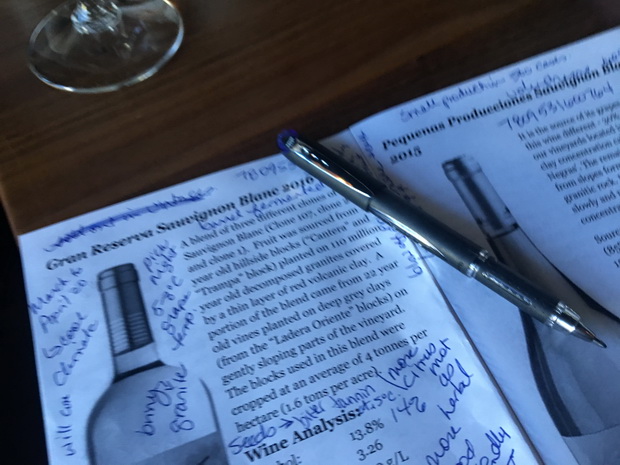
Grant Phelps
In January 2010, the New Zealander, Grant Phelps came to work as winemaker and chief of Casas del Bosque. He holds a masters degree in Oenology and Viticulture; he has worked in important vineyards in many different climates such as Australia, now as Chief Winemaker, he is responsible for all the different steps of the winemaking process, making sure to maintain the strict conditions that are required of Casas del Bosque products.
Casas del Bosque Gran Reserva Sauvignon Blanc 2016
Casablanca Valley, Chile
Casas del Bosque Pequenas Producciones Sauvignon Blanc 2015
Casablanca Valley, Chile
Casas del Bosque Pequenas Producciones Sauvignon Blanc 2014
Casablanca Valley, Chile
Casas del Bosque Pequenas Producciones Sauvignon Blanc 2013
Casablanca Valley, Chile
Casas Del Bosques Reserva Pinot Noir 2014
Casablanca Valley, Chile
Casas del Bosque Gran Reserva Pinot Noir 2013
Casablanca Valley, Chile
Casas del Bosque Gran Reserva Syrah 2014
Casablanca Valley, Chile
Casas del Bosque Pequenas Producciones Syrah 2014
Casablanca Valley, Chile
Casas del Bosque Pequenas Producciones Syrah 2013
Casablanca Valley, Chile
Casas del Bosque Pequenas Producciones Syrah 2012
Casablanca Valley, Chile
Casas del Bosque Reserva Carmenère 2014
Casablanca Valley, Chile
Casas del Bosque Gran Reserva Cabernet Sauvignon 2014
Maipo Valley, Chile
Casas del Bosque Reserva Sauvignon Blanc 2015
Casablanca Valley, Chile



